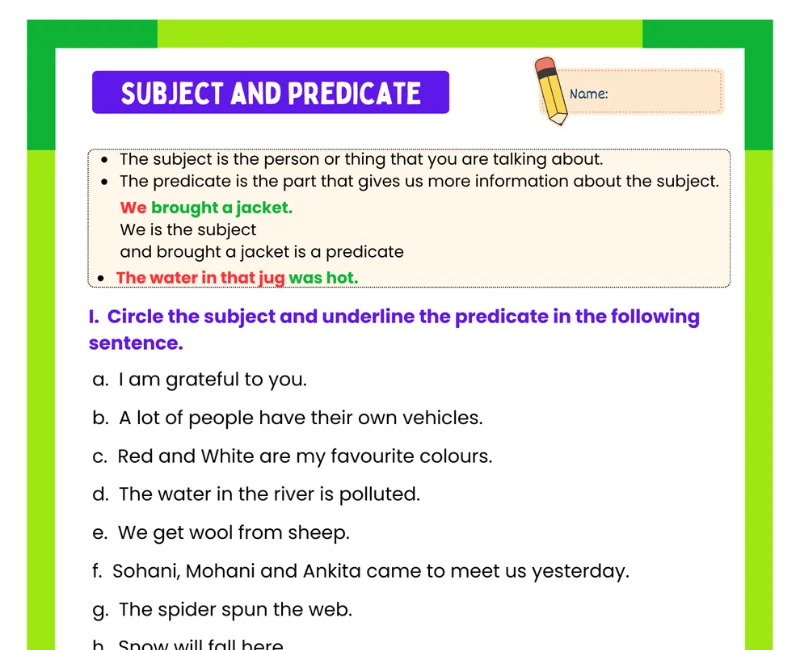Introduction
The ability to correctly identify the subject and predicate of a sentence is a cornerstone of grammar and writing. For students, mastering these two parts transforms jumbled phrases into clear, meaningful sentences. A subject and predicate worksheet is a practical tool that not only reinforces this skill through repetition and examples, but also helps build confidence in sentence construction. Worksheets range from simple exercises (identifying subject or predicate) to more complex tasks (complete vs simple subject, compound forms, etc.).
Whether learners are in primary grades or brushing up their skills later, well-structured worksheets offer guided practice, allow self-checking, and support understanding of how sentences are put together. In this article, we’ll explore what makes an effective subject and predicate worksheet, provide examples, discuss how they are used in class and home settings, and answer common questions around choosing or designing the right worksheet.
What are Subject and Predicate?
- Subject: the part of the sentence that tells who or what the sentence is about. For example, in “The cat sleeps on the mat,” The cat is the subject.
- Predicate: everything else in the sentence that tells what the subject does or is. In that example, sleeps on the mat is the predicate.
- There are simple vs complete subjects/predicates:
- Simple subject is the core noun or pronoun.
- Complete subject includes modifiers.
- Simple predicate is the main verb.
- Complete predicate includes all words that are part of the verb phrase, plus modifiers, objects, etc.
- There can also be compound subjects or compound predicates, when more than one subject or predicate is present.

What Makes a Good Subject and Predicate Worksheet?
A high-quality worksheet should include:
- Clear definitions and examples so students understand before practicing.
- Variety of sentence types including simple, compound, and complex sentences.
- Exercises for both recognition and creation, encouraging students not only to identify but also write sentences.
- Incremental difficulty beginning with basic sentences and moving to advanced structures.
- Answer keys or feedback for self-correction or guided learning.
- Visual clarity such as neat layouts, tables, and space for writing.
- Examples of Worksheet Activities
Jack and the Beanstalk: A Classic Tale of Courage, Cleverness, and Consequence
Here are common types of exercises you’ll find in subject and predicate worksheets:
- Identify the subject and predicate: Students underline or circle each part in given sentences.
- Split sentences: Divide a sentence into subject and predicate using a line.
- Match exercises: Match a subject from one column with a predicate from another.
- Complete the sentence: Provide either the subject or predicate and let students complete the other half.
- Differentiate between simple and complete parts: Identify just the core subject or verb, then expand to the full version.
- Compound practice: Work with sentences that contain more than one subject or predicate.
- Create your own: Encourage learners to build full sentences starting from a given subject or predicate.
Using Worksheets Effectively
- In-class instruction: Begin with teacher-guided examples before handing out worksheets.
- Homework practice: Assign worksheets for extra reinforcement at home.
- Differentiated learning: Some learners may only need simple identification, while others benefit from advanced exercises.
- Group activities: Students can swap sentences and test each other’s skills.
- Test preparation: Mixed worksheets serve as excellent review material before grammar assessments.
- Self-learning: Worksheets can be used independently for practice and improvement.
Benefits of Subject and Predicate Worksheets
- Strengthens grammar foundation by focusing on sentence structure.
- Improves writing clarity since students learn to form complete sentences.
- Enhances reading comprehension by understanding how ideas connect in text.
- Boosts confidence as learners quickly recognize sentence parts.
- Supports language development across all grade levels.
Conclusion
Mastering the subject and predicate in sentences is one of the most important steps in learning grammar. Worksheets provide a structured and engaging way to practice these concepts, helping learners move from theory to application. By working through different exercises, students learn to recognize sentence parts, construct their own sentences, and refine their writing skills. The beauty of subject and predicate worksheets lies in their flexibility: they can be used in classrooms, at home, or even for self-study.
Over time, the consistent practice makes sentence identification automatic, leading to stronger comprehension and clearer expression in both written and spoken communication. Ultimately, a simple worksheet becomes more than just an exercise—it becomes a tool for building lifelong language skills.
5 FAQs About Subject and Predicate Worksheets
1. What is a subject and predicate worksheet?
It’s a practice sheet with exercises that help learners identify the subject (who or what the sentence is about) and predicate (what is said about the subject).
2. Why are these worksheets important?
They simplify grammar learning by providing repetitive, clear practice that builds confidence and improves both reading and writing.
3. What types of exercises do they include?
Activities range from identifying and underlining subjects/predicates, splitting sentences, matching, completing sentences, and writing new examples.
4. How do teachers or parents use them effectively?
By starting with examples, assigning practice gradually, mixing difficulty levels, and encouraging both recognition and creation of sentences.
5. Can these worksheets help in other areas of learning?
Yes. They strengthen grammar, punctuation, comprehension, and overall communication skills—benefiting students across all subjects.


